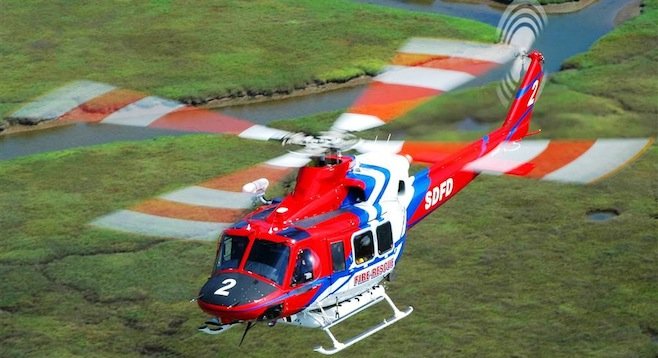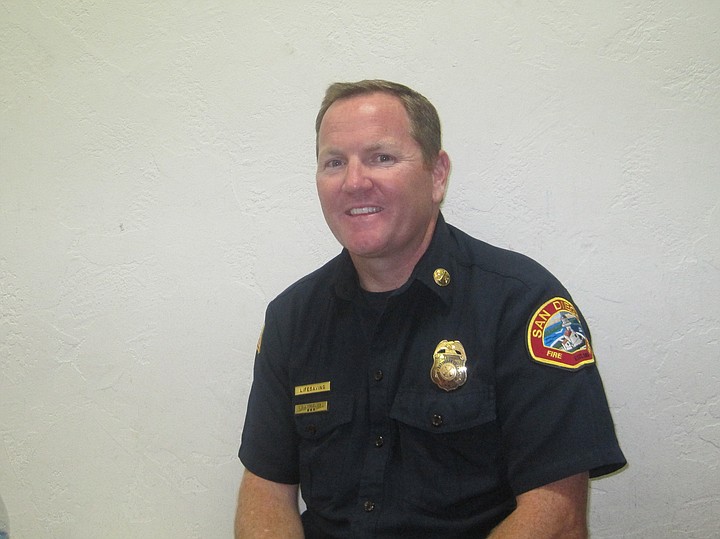 Facebook
Facebook
 X
X
 Instagram
Instagram
 TikTok
TikTok
 Youtube
Youtube

Cowles Mountain was the site of 22 rescues during 2013, San Diego Fire-Rescue battalion chief Dan Froelich said in a July 6 interview; 32 rescues were conducted in Mission Trails Regional Park last year. The calls formatted as "miscellaneous rescues" in the park involved locations including the visitor center in San Carlos and the equestrian area in Santee.
The Cowles Mountain incidents were "most likely helicopter rescues," he said.

In the interview, Froelich elaborated on his presentation at the July 2 San Carlos Area Council meeting. Earlier that day, Froelich said a helicopter responded to a call in a park area west of Santee. When a body was discovered, San Diego police were called to investigate. (No details were available at press time.)
Froelich also responded to the statement that there was no charge for helicopter rescues. While there is no cost recovery for the helicopter, he said expenses include fuel.
There is a charge for transport in a Rural/Metro of San Diego ambulance. The injured person is usually flown "off the mountain" to a Santee location at State Route 52 and Mast Boulevard and transferred to the ambulance, Froelich told residents.
(The City of San Diego contract set that cost at $1584, Michael Simonsen, Rural/Metro spokesman said in a July 7 interview. A health plan may reduce the cost to a co-pay or no charge, he said.)
Cowles Mountain has an altitude of 1591 feet, and the trail accessed from Golfcrest Drive is described on the park website as "the most popular (and populated) trail" in the county.
Froelich said in the interview that Cowles Mountain rescues involve a "variety" of conditions, including twisted ankles and heart attacks.
The two fire-rescue helicopters at Montgomery Field are among the department's on-call resources. The helicopter with a paramedic aboard is plan A "when a helicopter is available and able to fly. We can't base our assets on weather or something happening in town," he said.
Plan B is the ground crew.
When the helicopter is used, mild cases are flown to the ambulance. When the condition is critical, Froelich said the helicopter flies to the hospital. In some situations, the ground crew may carry the injured hiker down the mountain or walk with the person.
Froelich said that rescue time varies because of factors such as the time of day and the injured person's location. The hiker may be at the top of Cowles; the crew may need to use a Stokes stretcher, a body-shaped litter.
"That's the reason there are so many ground resources," he said.
Trying to locate the person could also take time. While hiking, "know your location; be aware of trail markers," Froelich advised.
"Often, people are not prepared," he said. "They may drive an hour before sunset and [then] hike. Plan what to do. Bring a flashlight, and wear the right shoes. Bring water, a jacket, and means to communicate. Let people know what you're doing."
(corrected 7/8, 8:20 p.m.)


Cowles Mountain was the site of 22 rescues during 2013, San Diego Fire-Rescue battalion chief Dan Froelich said in a July 6 interview; 32 rescues were conducted in Mission Trails Regional Park last year. The calls formatted as "miscellaneous rescues" in the park involved locations including the visitor center in San Carlos and the equestrian area in Santee.
The Cowles Mountain incidents were "most likely helicopter rescues," he said.

In the interview, Froelich elaborated on his presentation at the July 2 San Carlos Area Council meeting. Earlier that day, Froelich said a helicopter responded to a call in a park area west of Santee. When a body was discovered, San Diego police were called to investigate. (No details were available at press time.)
Froelich also responded to the statement that there was no charge for helicopter rescues. While there is no cost recovery for the helicopter, he said expenses include fuel.
There is a charge for transport in a Rural/Metro of San Diego ambulance. The injured person is usually flown "off the mountain" to a Santee location at State Route 52 and Mast Boulevard and transferred to the ambulance, Froelich told residents.
(The City of San Diego contract set that cost at $1584, Michael Simonsen, Rural/Metro spokesman said in a July 7 interview. A health plan may reduce the cost to a co-pay or no charge, he said.)
Cowles Mountain has an altitude of 1591 feet, and the trail accessed from Golfcrest Drive is described on the park website as "the most popular (and populated) trail" in the county.
Froelich said in the interview that Cowles Mountain rescues involve a "variety" of conditions, including twisted ankles and heart attacks.
The two fire-rescue helicopters at Montgomery Field are among the department's on-call resources. The helicopter with a paramedic aboard is plan A "when a helicopter is available and able to fly. We can't base our assets on weather or something happening in town," he said.
Plan B is the ground crew.
When the helicopter is used, mild cases are flown to the ambulance. When the condition is critical, Froelich said the helicopter flies to the hospital. In some situations, the ground crew may carry the injured hiker down the mountain or walk with the person.
Froelich said that rescue time varies because of factors such as the time of day and the injured person's location. The hiker may be at the top of Cowles; the crew may need to use a Stokes stretcher, a body-shaped litter.
"That's the reason there are so many ground resources," he said.
Trying to locate the person could also take time. While hiking, "know your location; be aware of trail markers," Froelich advised.
"Often, people are not prepared," he said. "They may drive an hour before sunset and [then] hike. Plan what to do. Bring a flashlight, and wear the right shoes. Bring water, a jacket, and means to communicate. Let people know what you're doing."
(corrected 7/8, 8:20 p.m.)
Comments